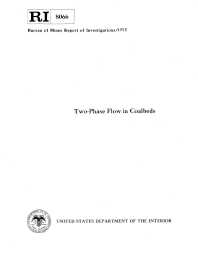Mining Publication: Two-Phase Flow in Coalbeds
Keywords:
Original creation date: January 1975
Experimental work by the Bureau of Mines indicates that when a coalbed is degassed by boreholes, the flow of methane may actually increase with time. This phenomenon appears to be the result of a relative permeability effect; that is, the coalbed permeability to the gas increases sharply with decreasing water saturation. This report reviews the background of experimental evidence indicating a relative permeability effect and presents the results of a computer simulation of two-phase flow in coal.
Authors: FN Kissell, JC Edwards
Report of Investigations - January 1975
NIOSHTIC2 Number: 10000735
Pittsburgh, PA: U.S. Department of the Interior, Bureau of Mines, RI 8066, 1975 Jan; :1-16
See Also
- A CART Technique to Adjust Production from Longwall Coal Operations under Ventilation Constraints
- Coal Mine Methane: A Review of Capture and Utilization Practices with Benefits to Mining Safety and to Greenhouse Gas Reduction
- Development and Application of Reservoir Models and Artificial Neural Networks for Optimizing Ventilation Air Requirements in Development Mining of Coal Seams
- Historical Development of Technologies for Controlling Methane in Underground Coal Mines
- Methane Control by Isolation of a Major Coal Panel - Pittsburgh Coalbed
- Methane Drainage: Experience With Hydraulic Stimulation Through Slotted Casing
- A Numerical Evaluation on the Effects of Impermeable Faults on Degasification Efficiency and Methane Emissions During Underground Coal Mining
- Removing Methane (Degasification) from the Pittsburgh Coalbed in Northern West Virginia
- Rotary Drilling Techniques Used in the Beckley Coalbed
- Three Coal Mine Gob Degasification Studies Using Surface Boreholes and a Bleeder System
- Content source: National Institute for Occupational Safety and Health, Mining Program


 ShareCompartir
ShareCompartir
